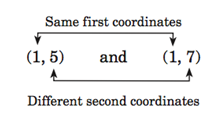Functions
A relation is called a function if no two distinct ordered pairs in it have the same first coordinate. For example, the relation is a function. On the other hand, the relation is not a function since the ordered pairs and have the same first coordinate, which is −1.
The relation is also not a function because one element of the domain corresponds to two distinct elements of the range. The element 1 is paired with two elements, namely, 5 and 7.

The set in the previous example, is another example of a function. Note that each first coordinate is paired with exactly one second coordinate and that each second coordinate is also paired with exactly one first coordinate. This function is called a one-to-one function. A one-to-one function is a function in which no two different ordered pairs have the same second coordinate.
Which of the following relations is a function?
Only relation T is a function.
